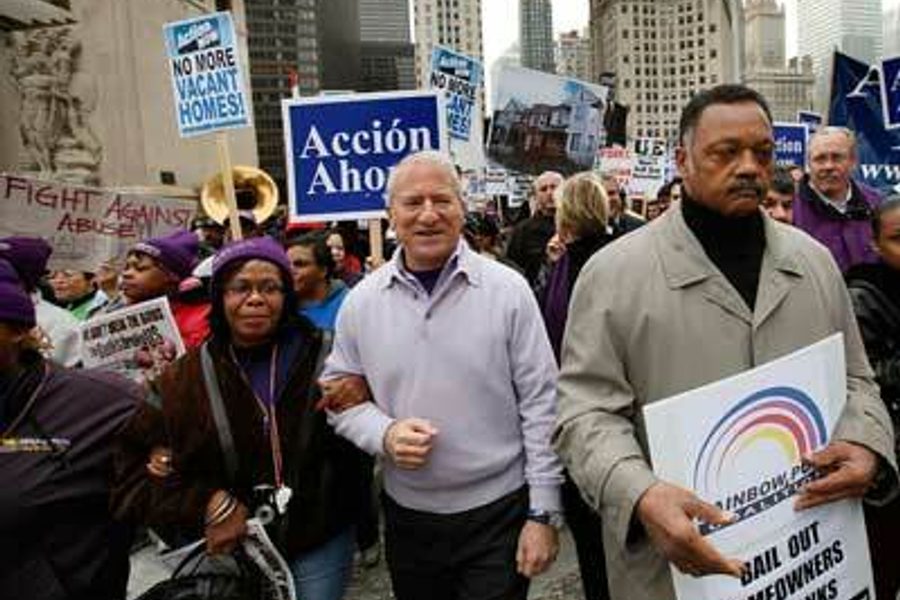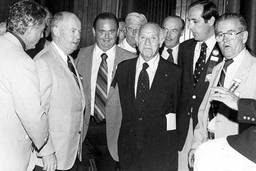
The news this week that Andy Stern is resigning as president of the Service Employees International Union came as a shock to some, but not to those who’ve known him for any amount of time. (Editor’s note: Stern’s official farewell video, released April 14, is below.)
For me, his departure at the youngish age (at least for a labor leader) of 59 is far from surprising: a man who’d been unable to measure up to many of the high standards he’d set for himself was living up to at least one of them, namely that union leaders shouldn’t hang onto their positions of power and influence until they are so old their “vision” can’t tell the difference between a picket line and a pimped-out contract.
The major media is playing his legacy as a mixed bag. Alec MacGillis of the Washington Post, not long with labor, wrote the most critical review. Even old timers like Steve Greenhouse of the New York Times, and Post columnist Harold Meyerson took some sharp jabs at him. All of them credited Stern with recruiting hundreds of thousand of janitors and other low-wage workers, and with becoming a dominant national political figure.
However, none of them noted (or perhaps even knew of) the bodacious business decision he made early in his presidency that transformed SEIU from a gaggle of independent local chapters that got less respect than Rodney Dangerfield into a national political juggernaut.
The Building Service Employees International Union was founded in the 1930s as a union for low-paid janitors and elevator operators. After its membership grew quickly to 400,000, it was briefly taken over by the mob in the 1940s. When elevator operators were rendered obsolete in the early 1950s, the union turned to organizing workers that were blocked by law from joining unions, first hospital and nursing home employees, then public employees. Because it represented low-wage workers, the union kept it dues at about half the rate of most unions, less than that when compared to some of the craft and industrial unions.
When John Sweeney was elected BSEIU president in 1980, it had rebuilt its membership to about 500,000 and changed its name to the Service Employees International Union. In 15 years, under Sweeney, SEIU grew to about 1 million members, most of which were added via mergers and affiliations of independent public sector associations of state, local and school board employees.
When Stern was elected president of SEIU in 1995, the union was about evenly divided between building service workers (janitors), health care workers, and public employees. Decision-making was dominated by large local unions in New York, Chicago, San Francisco, and Los Angeles, aided by smaller groups in cities like Boston, St. Louis, Cleveland, and Seattle. Sweeney had brought them together to make endorsements in presidential races and to support progressive causes, but they’d forced him to forego all but minimal dues increases, and SEIU was a big, but underfunded colossus.
Shortly after his election, Stern asked me to join Dean Tipps (founder of Citizens for Tax Justice, victor over Howard Jarvis in 1980, long-time SEIU state director in California) in evaluating membership attitudes towards a substantial dues increase. We commissioned a national membership poll, and conducted focus groups in a dozen cities. We learned that rank-and-file members would go along with a big dues increase, as long as they were assured the money would fund organizing, and not be siphoned off into salaries and perks for leaders and staff.
When we met with Stern, we sucked up our courage, ran through the charts and graphs with cocky self-assurance, and ended the presentation by recommending a 50 percent dues increase that would yield the income needed for SEIU to become, at last, a major player.
Stern looked back at us with what I can only describe as gunslinger’s eyes and replied, “I’m going to double them”
Using the research as a club, he convinced a majority of his leadership to support the audacious increase and pushed through an overwhelming convention vote. The money poured in and he used it to create a new hybrid-model organizing and political machine that doubled SEIU’s membership over the next 14 years and thrust the union into the leadership of the American progressive movement.
Some say he used too much of the money to eliminate political opponents within the union, and to buy the support of progressive allies on the outside. Others will no doubt point to his questionable support of corrupt politicians like Illinois Governor Rod Blogovavich, employee thefts that took place on his watch, or the union’s recent commitment to founding and presumably financing a third political party in North Carolina. For myself, I thought he was selfish, destructive and pig-headed for using his size and financial independence to leave the AFL-CIO, and I think he went way overboard in staging lavish meetings and conventions.
But as Andy Stern steps down, his successor will inherit an organization that has the financial base to continue innovating in organizing and leading multiple fights for immigration and labor law reform, re-regulation of our financial markets, and the redirection of our economy.
With one decision, he’d muscled up the money to build a big-time union. And they/we can’t that away from him.
This post originally appeared at From the Left Bank of the Potomac.







